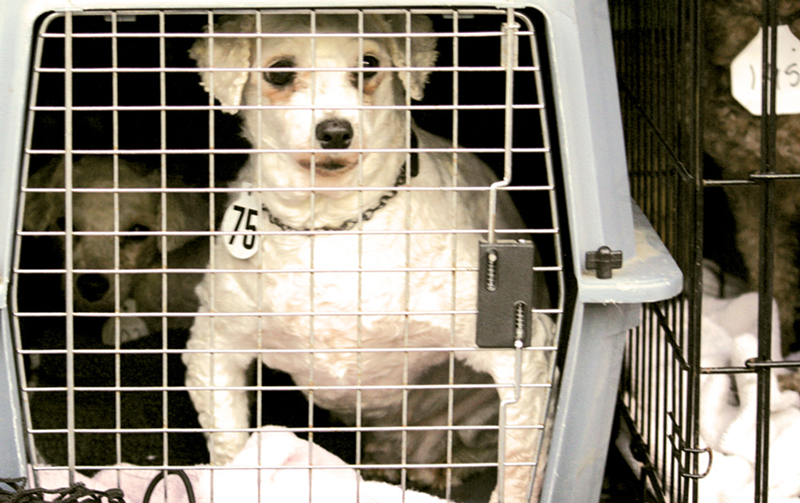W
e’ve got three ‘02-model females,” the auctioneer began.
A seated crowd of bonnets and wide-brim hats peered down into the auction pit, where three small white dogs stood on a rug-covered table. A teenage boy held each one in place.
In lots 73-75, three Bichon Frises registered under the names Mandy, Crystal, and Pebbles were shaking.
Maybe they felt cold, or maybe they felt scared. It was a January morning, their curls had been shorn off and until that moment they had been tasked with bearing litters of puppies in a large breeding facility known for its small cages, where they had probably never felt so many human eyes upon them.
Mandy’s ears froze into an odd crimp, as the auctioneer announced the starting price for her. There were no takers. The price dropped, then dropped again several times, and he gave up. Crystal, a runt, fared the same. The third, Pebbles, whose short legs bowed awkwardly around her tomato-shaped body, fetched a single bid: $5.
The three mothers were among 301 dogs that rode 900 miles last January inside cage-stacked semi tractor-trailer trucks, from Clearwater Kennel in Cushing, Minn., to the Farmerstown Sale Barn in the Amish town of Baltic, Ohio.
Their ride could have been shorter if Minnesota or any of its neighbors had a dog auction of its own. But none of them did, and Ohio’s was the closest. Wisconsin and Pennsylvania have banned the events.
Now, a citizen-initiated statute has reached the Ohio General Assembly after eight years of protests and a two-year signature drive by an Ohio volunteer group called the Coalition to Ban Ohio Dog Auctions (CBODA). The statute would ban the sale of dogs through auctions or raffles, as well as all trafficking in dogs from out-of-state auctions.
The General Assembly has until May to vote on the statute; if it doesn’t pass there, it will go on the ballot in November.
Mary O’Connor-Shaver, the campaign’s leader, says the neglect she saw during a 2006 visit to the Buckeye Dog Auction (now the Ohio Dog Auction) spurred her to action. Along with quaking dogs and feces-filled cages, she saw a German Shepherd that was urinating blood and missing a large piece of her lip. After the auction awarded the dog to a rescue group, O’Connor-Shaver nursed her to health and found her an adoptive family in Columbus.
The most serious problem with the auction, she says, is that “we know it’s a major distribution channel for puppy mill breeders.”
In fact, she alleges that it not only supplies the disreputable breeders referred to as “puppy mills” — which breed dozens or hundreds of dogs at a time in factory-like conditions — but draws them into Ohio from states where they have failed to meet animal welfare standards.
One such breeder is Lanzie Horton, Jr., a Virginia man charged in 2007 with multiple accounts of animal abuse and neglect after police discovered almost 1,100 dogs on his property. After insisting to a local TV news crew that he had done nothing wrong, Horton moved to Ohio, where — unlike in Virginia — convicted animal abusers are welcome to open kennels. He now raises dogs again in Coshocton County, northeast of Columbus.
According to CBODA, the number of Ohio puppy mills has increased by around 400 percent since the auction opened.
Amish commercial breeder Ervin Raber opened the auction in 2003, it changed ownership three times and most recently took place at the Farmerstown Sale Barn, a private space where journalists, cameras and cell phones are prohibited.
Last April the auction was suspended as it shifted into the hands of the Ohio Professional Dog Breeders Association, a group comprised of 90-percent Amish puppy mill owners, of which Raber is president. Polly Britton, a forceful lobbyist against the regulation of Ohio’s animal industries, represents the association and opposes the ban.
After last January’s auction, Pebbles and four other small dogs were transferred between two vans in a Grove City parking lot. Because they looked so ragged, a purchaser had bought them for delivery to Luv4K9s, a Dayton-based rescue group that rehabilitates and socializes puppy mill dogs.
Melody Brackney, the group’s president, lifted Pebbles out of a traveling crate and inspected her.
Wide-eyed and passive, Pebbles licked the air, the number 75 still dangling around her neck. Her paws were inflamed and her toes splayed — a result, Brackney suspected, of standing on an uncovered wire floor and licking.
There were also urine-colored spots on her back, and a tumor growing out of one ear.
These were common problems at Clearwater Kennel. A 2010 USDA inspection found dogs with lesions between their toes and inflamed eyes, all untreated, along with inadequate space for puppies.
Reports of similar and worse violations in Ohio have inspired a growing opposition to the puppy mill proliferation and several legislative efforts to send them packing.
But a bill that passed unanimously through the Ohio Senate this month, S.B. No. 130, was so thoroughly reworked by the breeding industry that it could actually help to entrench Ohio’s puppy mills. High-volume breeders would not be restricted, whereas rescue groups of any size, like Luv4k9s, would need to be registered.
For now, Brackney’s group looks for small encouragements. Pebbles had so many health problems that she stayed with Brackney, whom she grew to trust as her curls grew out and she assumed the name Blondie. It turned out that she had been debarked — her vocal cords were cut — and her foot problems mean that Brackney often has to lift her out the front door.
But Blondie has learned to live comfortably with her new family, and after eight years in the hole, that's more than some puppymill dogs ever manage to do.
'When one picks up a toy, or runs and jumps in your lap for the first time," says Brackney, "those are big moments." ©


